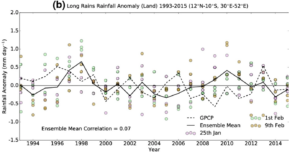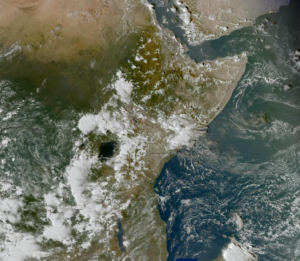A Machine-Learning approach to understanding and predicting the East African Long Rains
The East African Long Rains (March-May) are of vital importance to food security in East Africa. Agriculture in the region is largely rain-fed, and the performance of the long rains influences the availability and affordability of food in the region. The recent spell of 5 consecutive drier-than-average seasons led to food security challenges across the region; the following wetter-than-average season gave rise to extensive flooding. Seasonal and shorter timescale forecasts are crucial for planning and yet have poor skill at this crucial time of year.

Future projections for the region under a changing climate are uncertain, with the envelope of potential outcomes spanning both increases and decreases in total rainfall. Thus seasonal (and shorter timescale) forecasts are key for both short-term preparedness and long-term adaptation to changing climate and variability. In this project we will apply state-of-the-art machine learning methods to the challenge of improving seasonal and sub-seasonal forecasts during the long rains. This research has the potential to bring significant benefits to farmers and humanitarian actors across the region.
In this PhD, you will explore recent trends and changing variability in the East African long rains, especially considering recent seasons. You will explore the role of well-established drivers of variability on the long rains. In particular, the role of different drivers across different regions, and the changing role of these drivers throughout the season will be explored.
Machine-learning (ML) forecasting models will be developed and interrogated to explore the spatial and temporal variability of these drivers and their relative influence on the long rains. Model selection and development will be optimized for performance in non-stationary environments. Meanwhile, cutting edge developments in Explainable Artificial Intelligence (XAI) will be employed to assess the importance of new drivers (for example ocean heat content) and to search for drivers that have yet to be identified.
There is also scope for targeting variables according to your sector of interest. For example, work could consider how ML can be used to improve the forecasting of specific user-relevant variables such as wet season onset or prolonged dry spells. Work in this PhD could also consider the decision-making context, and how forecast models and ML are used to inform early warning – early action in East Africa. This can be developed with the guidance of supervisors as the project progresses.
The PhD student will share their work with ICPAC, the regional climate centre for East Africa. Existing ICPAC collaborations among the supervisory team will be drawn upon to ensure that new scientific findings have a route for uptake among those responsible for delivering seasonal forecasts in East Africa. In doing so, findings from the PhD have the potential to improve the livelihoods of people in East Africa. There will be an opportunity for the PhD student to travel to East Africa to meet with forecasters and stakeholders during climate outlook fora. You will also have the opportunity to present your findings at major international conferences.
This project would be suitable for a student with a mathematical background (e.g. computer science, maths, statistics, physics, meteorology) looking to further their knowledge of AI/ML and its application in climate science. During the course of the PhD you will have opportunity to attend courses on AI/ML and statistics. The training you will receive will equip you to work in data science, climate tech or research after completion of the PhD.

